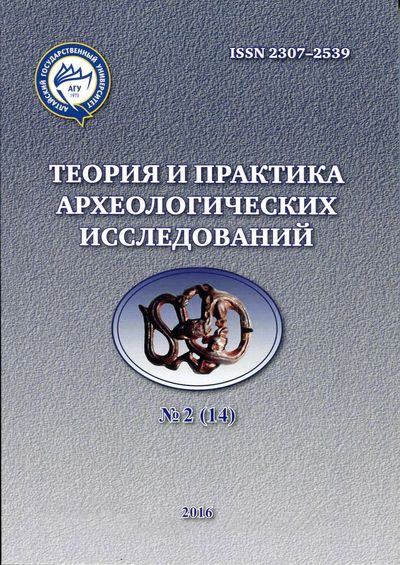BURIAL CHAMBERS OF THE KOFUN PERIOD MOUNDS IN THE CENTRAL AREA OF THE KANSAI REGION, JAPAN
Abstract
The Kofun period is named after the tomb mounds or kofuns that were built for the members of the ruling class of that time in the 3-7 centuries AD. Among the main types of tumuli differing in their external structure, the large square-round mounds were supposedly built for the Emperors. Mounds of various shapes and sizes were constructed for the high-ranking officials, local chieftains, and clan representatives. There is a certain difference in the structure of the mounds and in the sarcophagi used for buring. The origins of stone cist construction in kofuns can be traced back to the funkyubo burials in late period of the Yayoi era. The transformations of burial chamber structure can be observed at different stages of the Kofun period. On the initial stage, “tateana sekisitsu” or vertical burial chambers with a wooden coffin fixed on a clay floor were constructed. The walls were made of stone slabs tightly fit together. Ceiling rocks were laid to close the chamber. Then the holes were filled with soil or hermetically sealed with clay mass. Drainage channels were constructed inside the chamber to prevent the ingress of water on the coffin. On the next stage, stone sarcophagi were used in the vertical burial chambers. The tradition to construct horizontal stone chambers is thought to have been borrowed from the Korean peninsulat the end of the 4th - beginning of the 5th century. The horizontal burial chamber (“Yokoana sekishitsu”) was constructed in a round part of the square-round mounds. In the late Kofun period, when square-round kofuns were not constructed any more, such chambers were built in round and square tumuli. Stone sarcophagi were used in the horizontal burial chambers. On the late stages, megaliths were used in the construction of horizontal chambers. The introduction of Buddhism and strengthening of the cremation practice stopped the practice of Kofuns construction.
Downloads
Metrics
References
Vorob’ev M.V. Drevnyaya Yaponiya [Ancient Japan]. Moscow : Izd-vo vostochnoy literatury, 1958. 181 p [In Russian]. Воробьев М.В. Древняя Япония. М. : Изд-во восточной литературы, 1958. 181 с.
Istoriya Yaponii. Vol. 1: S drevneyshikh vremen do 1868 goda [From the earliest times until 1868]. Moscow : Izd-vo Instituta vostokovedeniya RAN, 1998. 659 p [In Russian]. История Японии. Т. 1: С древнейших времен до 1868 года. М. : Изд-во Института востоковедения РАН, 1998. 659 с.
Kavakami K., Idzumi T., Miyakhara S., Urabe Yu., Okabayasi K., Nagura S. Raskopki kofuna Kurotsuka v Yanagimoto, g. Tenri, pref. Nara [Nara]. Arkheologicheskiy zhurnal [Archaeological Journal]. Journal of the Japanese Archaeological Association. 1999. Vol. 6, №7. С. 65–104 [In Japanese]. Каваками К., Идзуми Т., Мияхара С., Урабэ Ю., Окабаяси К., Натура С. Раскопки кофуна Куро-цука в Янагимото, г. Тенри, преф. Нара // Археологический журнал = Journal of the Japanese Archaeological Association. 1999. Т. 6, №7. С. 65-104 (на яп. яз.).
Kavakami K. Gorizontal’nye kamennye komnaty i kamennye sarkofagi v forme doma [Horizontal stone kitchen rooms and stone house-shaped sarcophagi ]. Kofuny Yamato II [Kofuns of Yamato 2]. Kioto : Dzimbunsein, 2006. Pp. 35–42 [In Japanese]. Каваками К. Горизонтальные каменные комнаты и каменные саркофаги в форме дома // Кофу-ны Ямато II. Киото : Дзимбунсёин, 2006. С. 35-42 (на яп. яз.).
Meshcheryakov A.N., Grachev M.V. Istoriya drevney Yaponii : uchebnoe posobie dlya vuzov [The history of ancient Japan: a textbook for colleges]. Moscow : Natalis, 2010. 544 p. [In Russian]. Мещеряков А.Н., Грачёв М.В. История древней Японии : учебное пособие для вузов. М. : На-талис, 2010. 544 с.
Okabayasi K. Koloda i sarkofag [Wooden blocks and sarcophagus]. Kofuny Yamato II [Kofuns of Yamato 2]. Kioto : Dzimbunsein, 2006. Pp. 25–34 [In Japanese]. Окабаяси К. Колода и саркофаг // Кофуны Ямато II. Киото : Дзимбунсёин, 2006. С. 25-34 (на яп. яз.).
Khirose K. Spravochnik po kofunam [Reference book on kofuns]. Tokio : Gentosya, 2015. 174 p. [In Japanese]. Хиросэ К. Справочник по кофунам. Токио : Гэнтося, 2015. 174 с. (на яп. яз.).
Eydus Kh.T. Istoriya Yaponii s drevneyshikh vremen do nashikh dney [The history of Japan from ancient times to the present day]. Moscow : Nauka, 1968. 224 p [In Russian]. Эйдус Х.Т. История Японии с древнейших времен до наших дней. М. : Наука, 1968. 224 с.
Imamura K. Prehistoric Japan. New Perspectives on Insular East Asia. Honolulu : University of Hawai’i Press, 1996. 246 р.
Pearson R. Fifth-century rulers of the Kawachi Plain, Osaka, and early state formation in Japan: some recent publications. Antiquity. June 2009. V 83, I. 320 (DOI: http://dx.doi.org/10.1017/ S0003598X00098641). Pp. 523-527.
Copyright (c) 2016 Теория и практика археологических исследований

This work is licensed under a Creative Commons Attribution-NonCommercial-NoDerivatives 4.0 International License.
Theory and Practice of Archaeological Research is a golden publisher, as we allow self-archiving, but most importantly we are fully transparent about your rights.
Authors may present and discuss their findings ahead of publication: at biological or scientific conferences, on preprint servers, in public databases, and in blogs, wikis, tweets, and other informal communication channels.
Theory and Practice of Archaeological Research allows authors to deposit manuscripts (currently under review or those for intended submission to ABS) in non-commercial, pre-print servers such as ArXiv.
Authors who publish with this journal agree to the following terms:
- Authors retain copyright and grant the journal right of first publication with the work simultaneously licensed under a Creative Commons Attribution License (CC BY 4.0) that allows others to share the work with an acknowledgement of the work's authorship and initial publication in this journal.
- Authors are able to enter into separate, additional contractual arrangements for the non-exclusive distribution of the journal's published version of the work (e.g., post it to an institutional repository or publish it in a book), with an acknowledgement of its initial publication in this journal.
- Authors are permitted and encouraged to post their work online (e.g., in institutional repositories or on their website) prior to and during the submission process, as it can lead to productive exchanges, as well as earlier and greater citation of published work (See The Effect of Open Access).








2.jpg)



